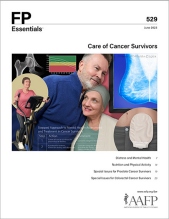
This clinical content conforms to AAFP criteria for CME.
Colorectal cancer (CRC) survival is influenced by numerous factors, including age, sex, race and ethnicity, familial cancer syndromes, stage and location of tumor, and comorbid conditions. The 5-year survival rate for patients with stage I CRC is 91%, but it is only 15% for patients with stage IV CRC. These survivors may experience multiple health issues. Gastrointestinal dysfunction is common, even years after treatment. This can include chronic diarrhea, occurring in approximately half of patients, and fecal incontinence, which is common after radiation therapy. Bladder dysfunction can occur due to surgical injury or radiation therapy. Many patients also experience sexual dysfunction. Standard therapies can be used to manage many of these symptoms and conditions. Patients with colostomy typically experience decreased quality of life. Referral to an ostomy therapist or wound, ostomy, and continence nurse may be beneficial. Pelvic radiation therapy can reduce bone mineral density (BMD) and increase fracture risk, so patients with rectal cancer who have received such therapy should undergo BMD monitoring. CRC survivors should undergo surveillance for recurrent CRC with interval colonoscopy, measurement of carcinoembryonic antigen levels, and computed tomography scan of the chest, abdomen, and/or pelvis. The intervals for and duration of surveillance depend on the cancer stage. Family physicians can help support CRC survivors through survivorship programs, shared care models, multidisciplinary interventions, and community partnerships.
Subscribe
From $350- Immediate, unlimited access to FP Essentials content
- 60 CME credits/year
- AAFP app access
- Print delivery available
Edition Access
$44- Immediate, unlimited access to this edition's content
- 5 CME credits
- AAFP app access
- Print delivery available
